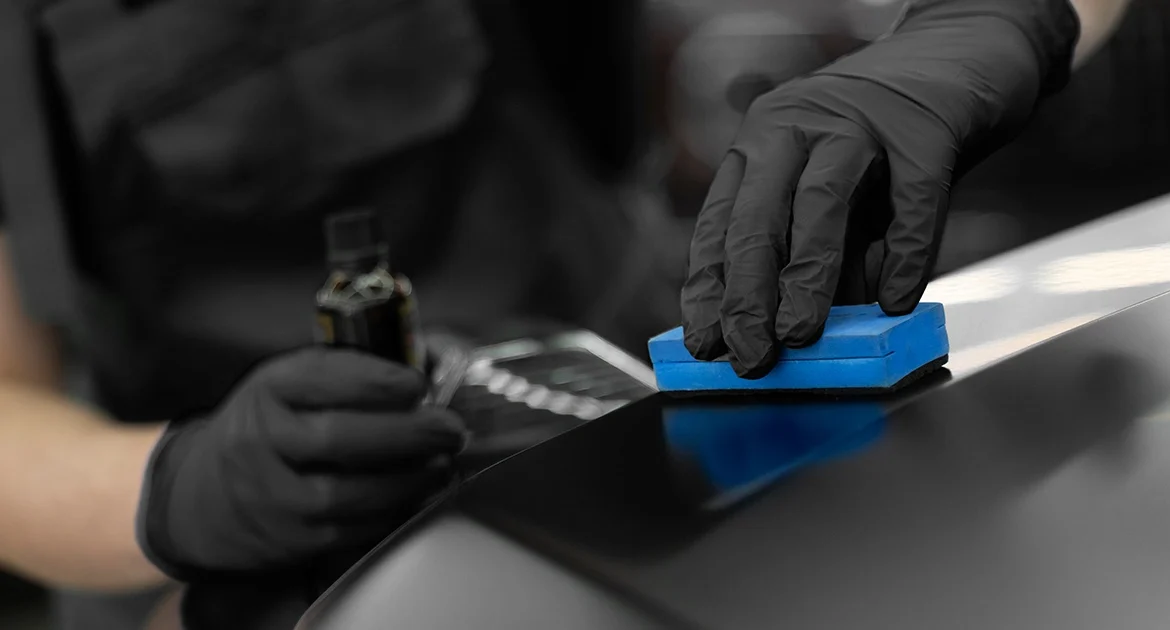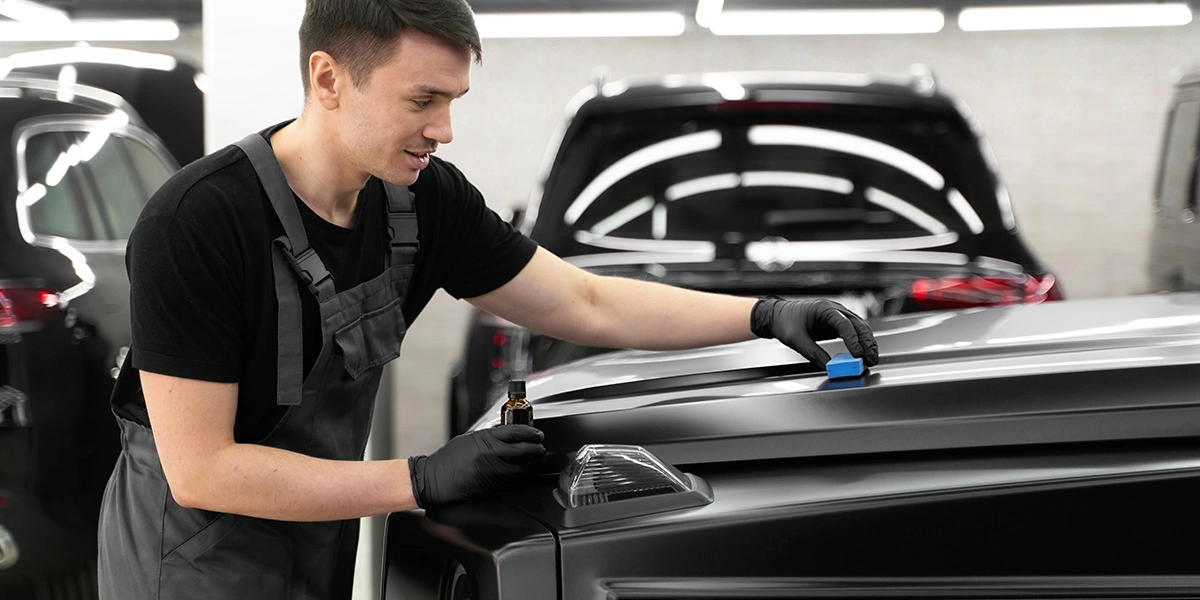When it comes to protecting your car’s paint and keeping it looking pristine, there’s a lot of buzz around ceramic coating. It’s often marketed as the ultimate solution to protect your vehicle against the elements, giving it a glossy finish while reducing the need for constant maintenance. But before you jump on the ceramic coating bandwagon, there are some key things you should understand. This blog will cover everything you need to know about ceramic coatings, including what they are, how they work, their benefits, potential drawbacks, and whether it’s the right investment for you.
What Is Ceramic Coating?
Ceramic coating is a liquid polymer that is applied to a vehicle’s exterior. It chemically bonds with the factory paint, creating a semi-permanent or permanent layer of protection. The main component of ceramic coatings is silica dioxide (SiO2), derived from quartz, sand, or ceramic. Some formulations may also contain titanium dioxide (TiO2) for additional durability.
Once cured, ceramic coating forms a hydrophobic (water-repellent) and transparent shield over the paint, enhancing its appearance and providing added protection against environmental contaminants.
How Does Ceramic Coating Work?
When applied, the ceramic coating forms a strong molecular bond with the paint. This bond ensures the coating stays on the surface for a long time, unlike traditional waxes or sealants that tend to wear off quickly. The hydrophobic properties of ceramic coatings mean that water, dirt, and grime slide off the surface more easily, making your car easier to clean.
The layer of protection also helps guard against:
- UV rays that cause paint to fade.
- Chemical stains from acidic contaminants like bird droppings or tree sap.
- Oxidation can lead to rust over time.
Benefits of Ceramic Coating
- Enhanced Appearance
One of the standout benefits of ceramic coating is the glossy, sleek finish it gives your car. The enhanced shine makes the paintwork pop, giving your car a showroom-like appearance for years to come. - Durability
Unlike waxes and sealants that wear off within months, ceramic coatings can last anywhere from 2 to 5 years or more, depending on the product and application process. - UV and Oxidation Protection
Prolonged exposure to sunlight can cause the car’s paint to fade or oxidize. Ceramic coating acts as a barrier against UV rays, keeping your car’s colour vibrant. - Hydrophobic Properties
Ceramic coatings repel water, making it harder for contaminants like dirt, mud, and road grime to stick. This reduces the need for frequent washing and ensures that cleaning your car is less of a hassle. - Chemical Resistance
Ceramic coating shields your car from harsh chemicals, such as those found in bird droppings, bug splatters, and tree sap, which can damage paint if left untreated. - Scratch Resistance
While ceramic coatings are not scratch-proof, they do offer a degree of scratch resistance, particularly against light scratches caused by improper washing techniques or dust. - Cost-Effective Maintenance
Over time, the reduced need for waxing, polishing, or constant cleaning can save you money, making ceramic coating a cost-effective option for maintaining your car’s finish.
Drawbacks of Ceramic Coating
While ceramic coating offers many benefits, it’s not without its limitations. Here are some things to consider:
- Not a Substitute for Paint Protection Film (PPF)
If you’re looking for protection against rock chips or deep scratches, ceramic coating isn’t the answer. Unlike paint protection films, ceramic coatings don’t offer significant impact resistance. - Cost
Professional ceramic coating applications can be expensive, often ranging from $500 to $2,000 or more, depending on the quality of the product and the expertise of the detailer. While DIY options are available, they often lack the durability and finish of professionally applied coatings. - Time-Consuming Application
The application process involves meticulous preparation, including washing, claying, and sometimes paint correction. Skipping any steps can result in an uneven or ineffective coating. - Maintenance Is Still Required
While ceramic coatings reduce maintenance, they don’t eliminate it. You’ll still need to wash your car regularly, using the right products and techniques to preserve the coating. - Not Permanent
Over time, even the best ceramic coatings can wear down. Reapplication may be necessary after a few years, depending on the coating’s longevity and how well you maintain it. - Potential for Application Errors
DIY ceramic coating kits are tempting because of their lower cost, but improper application can lead to streaking, hazing, or uneven coverage, which can detract from your car’s appearance rather than enhance it.
Things to Consider Before Getting a Ceramic Coating
-
Do You Really Need It?
Ceramic coating is ideal for car enthusiasts or anyone looking to preserve the aesthetics of their vehicle. However, if you’re not overly concerned about maintaining a showroom finish, you may find that wax or a sealant meets your needs at a fraction of the cost. -
Your Driving Environment
If you live in an area with harsh weather conditions, lots of tree sap, or frequent bird droppings, a ceramic coating can provide extra protection against these elements. -
Professional vs. DIY
While DIY ceramic coating kits are available, they can be tricky to apply correctly. A professional detailer will have the expertise and equipment to ensure a flawless application but at a higher cost. -
Upfront Cost vs. Long-Term Savings
The initial investment in ceramic coating may seem steep, but it can save you money in the long run by reducing the need for frequent detailing and waxing. -
Preparation and Maintenance
Proper surface preparation is critical to the success of ceramic coating. If your car has existing paint imperfections like scratches or swirl marks, you’ll need to address these beforehand, which can add to the overall cost.
Steps in Ceramic Coating Application
- Thorough Wash
Start with a thorough wash to remove dirt and contaminants from the car’s surface. - Decontamination
Use a clay bar to remove embedded contaminants that washing alone can’t eliminate. - Paint Correction
If your car’s paint has swirl marks, scratches, or oxidation, these must be corrected before applying the coating. - Application
The ceramic coating is applied in small sections and buffed out to ensure even coverage. - Curing Time
Allow the coating to cure fully, which can take several hours to days depending on the product.
Common Myths About Ceramic Coating
-
Ceramic Coating Is Scratch-Proof
While ceramic coatings are scratch-resistant, they are not scratch-proof. They can protect against minor abrasions but won’t stop deep scratches caused by keys, rocks, or accidents. -
You’ll Never Need to Wash Your Car Again
Ceramic coatings make washing easier, but they don’t eliminate the need for cleaning. Dirt and grime can still accumulate, although they’re easier to remove. -
It Lasts Forever
Ceramic coatings are durable, but they’re not permanent. Over time, environmental factors and regular wear will degrade the coating.
Is Ceramic Coating Worth It?
The value of ceramic coating depends on your priorities. If you’re someone who takes pride in maintaining the appearance of your car and wants to protect it against environmental damage, ceramic coating can be a worthwhile investment. However, if you’re looking for a budget-friendly solution or expect it to eliminate all maintenance needs, you might want to consider alternatives like waxes or sealants.
Ceramic coating is a powerful tool for preserving your car’s paint and enhancing its appearance, but it’s important to set realistic expectations. It’s not a magic solution that will make your car invincible, nor is it a one-size-fits-all answer to paint protection. Understanding its benefits, limitations, and maintenance requirements can help you make an informed decision.
If you’re serious about investing in ceramic coating, consider consulting with a professional detailer to ensure the best results. Alternatively, if you’re confident in your skills and want to save some money, DIY kits can be a good option—just be sure to follow the application instructions carefully.
At the end of the day, whether or not you choose ceramic coating, maintaining your car’s appearance will always require a combination of care, effort, and the right products.



Leave a Reply